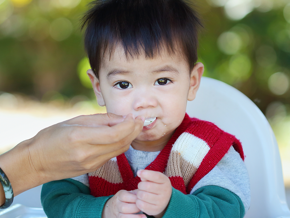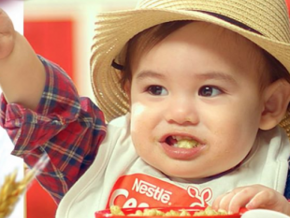
Turning Baby into a Solid Foodie!
Since birth, my baby has been on nothing but milk. Now that I have introduced him to solids, I am helping him discover not only new flavors, but completely different textures of food. It's a big breakthrough for him!
Chewing, like many developmental skills, depends upon a foundation of earlier experiences and abilities that babies learn and master. When they perfect their skill in mashing thicker pureed foods with their baby gums, they become ready to take in foods that have small lumps. Alam mo ba, mommy… that biting and chewing toys help prepare babies for lumpy textures of solid foods they will soon feed on?
Successful Solid Steps
Babies seem to learn most easily when parents use the following initial sequence:
1. Start with pureed food with different textures
- Give smooth thinly-pureed food
- Offer smooth pureed food slightly thickened with baby cereal. Or give homemade purees that are thick but smooth in texture.
- Introduce thicker pureed foods with small, soft, regular lumps of the same size and texture.
- Advance to thicker sauce-based foods that contain soft lumps of different sizes or textures.
TOP TIP! Provide baby with clean, safe toys of various shapes, textures and choke-proof sizes that he can happily chew on for practice.
2. Move to mashed table food
- Introduce 2 or 3 table foods finely mashed together and mixed with sauce.
- Give moist mashed table food without sauce.
3. Introduce soft solid finger foods
- Here’s the secret to first finger foods --- Offer only pieces of solid food that that baby can pick up with his small fingers, place it in his mouth where it rapidly melts in his saliva! Baby may mash the food for a short time with his gums but must not have to chew it yet.
- Introduce soft pieces of solid foods (fruits, vegetables, breads, meats) by putting in a small clean nylon mesh bag attached to his baby seat. Let baby put the food bag in his mouth or play with it, mashing the food to experience its taste. Since the pieces remain in the bag, there is no danger of baby choking on the food, ‘di ba?
- Provide bite-size solid foods that require very little chewing but can be mashed with the tongue and gums. These include mashed or finely chopped or diced vegetable and fruit that baby can easily pick up and put in his mouth with his fingers.
- Advance to foods that use more tongue and cheek manipulation for chewing. But remember --- do not offer solids (like meat, salads, raw veggies) that need grinding of teeth and moving food from one side of his mouth to the other. These are skills that your baby still has to learn in the next months.
Guidelines for parents
- Encourage and support your baby’s ability to put fingers, safe toys and objects in his mouth and to explore them with his jaw, lips, and tongue. Know that this is how most babies develop the first skills that will lead toward handling lumpy foods.
- Around 8 months, wait until your baby sits independently before introducing thicker purees and soft lumpy foods. Babies need to have the physical and neurological maturity to succeed in chewing. Siyempre, iba-iba naman ang babies --- not all of them are ready for this at the same age level.
- Your baby does not need to have teeth to learn to chew. The first steps of chewing require only tongue, jaw and cheek movements. Teeth are used later for more complicated food with fibers that must be broken up.
- Introduce new foods to your baby after offering enough of a familiar food or texture when he is not super hungry. You can give your baby the pureed food, then offer a small spoonful of the textured food mixed into the familiar puree, and again, a spoonful of the pureed food. Do this little by little. Then, you can also give spoonfuls of the textured food and follow it with several spoons of pureed food. Pretty soon, as your baby becomes used to the new texture, he will be able to eat only the textured foods.
Does my baby have a say in all this?
Even if you follow the step-by-step procedure, your baby still has the final word on this. Here are some tips to help your future foodie spot the difference between food textures:
- Offer him part of the meal puréed and the other part mashed or in small pieces, depending on his age.
- Occasionally let your child touch the food with his hands so that he develops all his senses.
- If your baby doesn't like a particular texture: wait a few days then, try the same texture again with a different food.
- If your baby refuses to taste a new food: don't force him to eat it. If getting him to eat solids turns out to be long stressful process, don't rush it. Never turn mealtimes into an emotional tug of war or a battle of wills by saying “Eat this for mommy” or something like that. Your baby may just need some time to adjust to all these new exciting foods!
Co-written with JENNIFER NAVAJA, RND
Related articles


















